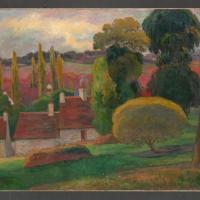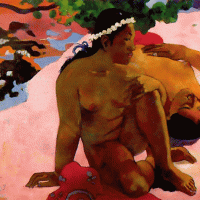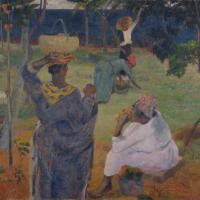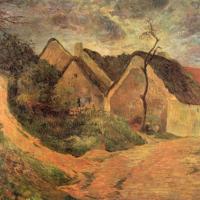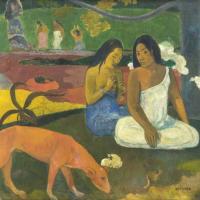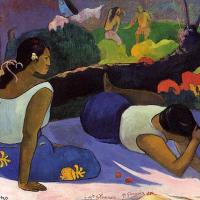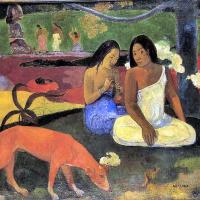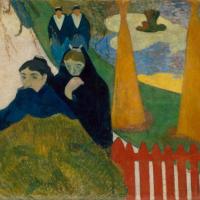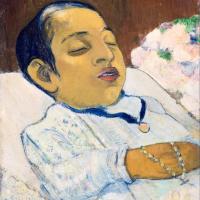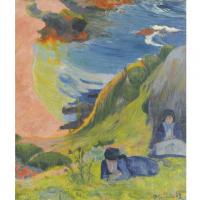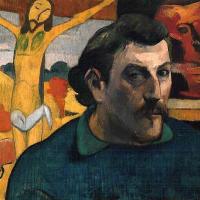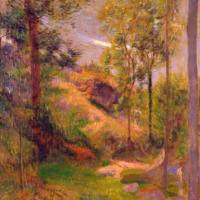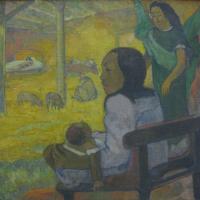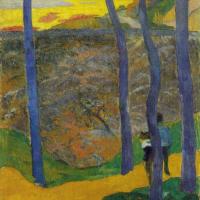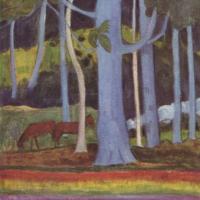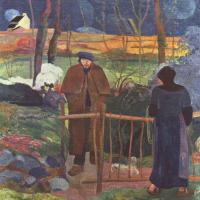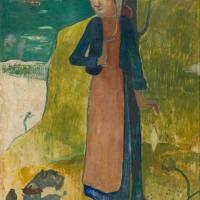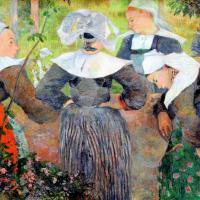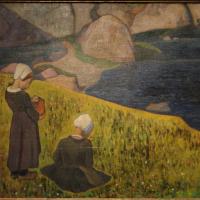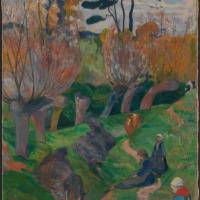Paul Gauguin
A Farm In Brittany
$450.00
Aha Oe Feii
$450.00
Ansteigender Weg In Osny
$450.00
Arearea
$450.00
Arearea No Varua Ino
$450.00
Arearea_1024
$450.00
Arlesiennes
$450.00
Atiti
$450.00
Au-Dessus De La Mer
$450.00
Autoportrait Au Christ Jaune
$450.00
Autorretrato Con Paleta
$450.00
Bebe
$450.00
Black Pigs
$450.00
Blue Trees
$450.00
bo vi tim khong ra
$450.00
bo vi Tranh trung
$450.00
Bonjour Monsieur Gauguin
$450.00
Breton Girl Spinning
$450.00
Breton Peasant Women
$450.00
Brittany Landscape With Cows
$450.00
Paul Gauguin
Paul Gauguin (1848-1903)
Eugène Henri Paul Gauguin (7 June 1848 – 8 May 1903) was a French post-Impressionist artist. Unappreciated until after his death, Gauguin is now recognized for his experimental use of color and Synthetist style that were distinctly different from Impressionism. Toward the end of his life, he spent ten years in French Polynesia, and most of his paintings from this time depict people or landscapes from that region.
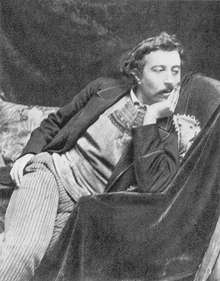
His work was influential to the French avant-garde and many modern artists, such as Pablo Picasso and Henri Matisse. Gauguin's art became popular after his death, partially from the efforts of art dealer Ambroise Vollard, who organized exhibitions of his work late in his career and assisted in organizing two important posthumous exhibitions in Paris. Gauguin was an important figure in the Symbolist movement as a painter, sculptor, printmaker, ceramist, and writer. His expression of the inherent meaning of the subjects in his paintings, under the influence of the cloisonnist style, paved the way to Primitivism and the return to the pastoral. He was also an influential proponent of wood engraving and woodcuts as art forms.
Gauguin was born in Paris to Clovis Gauguin and Alina Maria Chazal on June 7, 1848. His birth coincided with revolutionary upheavals throughout Europe that year.
In 1871, Gauguin returned to Paris where he secured a job as a stockbroker. A close family friend, Gustave Arosa, got him a job at the Paris Bourse; Gauguin was 23. He became a successful Parisian businessman and remained one for the next 11 years. In 1879 he was earning 30,000 francs a year (about $125,000 in 2008 US dollars) as a stockbroker, and as much again in his dealings in the art market. But in 1882 the Paris stock market crashed and the art market contracted. Gauguin's earnings deteriorated sharply and he eventually decided to pursue painting full-time.
In 1873, around the same time as he became a stockbroker, Gauguin began painting in his free time. In 1882, the stock market crashed and the art market contracted. Paul Durand-Ruel, the Impressionists' primary art dealer, was especially affected by the crash and for a period of time stopped buying pictures from painters such as Gauguin. Gauguin's earnings contracted sharply and over the next two years he slowly formulated his plans to become a full-time artist. The following two summers, he painted with Pissarro and occasionally Paul Cézanne. In October 1883, he wrote to Pissarro saying that he had decided to make his living from painting at all cost and asked for his help, which Pissarro at first readily provided.
Under the influence of folk art and Japanese prints, Gauguin's work evolved towards Cloisonnism, a style given its name by the critic Édouard Dujardin to describe Émile Bernard's method of painting with flat areas of color and bold outlines, which reminded Dujardin of the Medieval cloisonné enameling technique. His painting later evolved towards Synthetism in which neither form nor color predominate but each has an equal role.
Gauguin's Martinique paintings were exhibited at his color merchant Arsène Poitier's gallery. There they were seen and admired by Vincent van Gogh and his art dealer brother Theo van Gogh, whose firm Goupil & Cie had dealings with Portier. Theo purchased three of Gauguin's paintings for 900 francs and arranged to have them hung at Goupil's, thus introducing Gauguin to wealthy clients. At the same time Vincent and Gauguin became close friends (on van Gogh's part it amounted to something akin to adulation) and they corresponded together on art, a correspondence that was instrumental in Gauguin formulating his philosophy of art. The arrangement with Goupil's continued past Theo's death in January 1891.
Gauguin's relationship with Vincent proved fraught. In 1888, at Theo's instigation, Gauguin and Vincent spent nine weeks painting together at Vincent's Yellow House in Arles. Their relationship deteriorated and eventually Gauguin decided to leave. On the evening of 23 December 1888 according to a much later account of Gauguin's, van Gogh confronted Gauguin with a razor blade. Later the same evening, van Gogh cut off his own left ear. He wrapped the severed tissue in newspaper and handed it to a woman who worked at a brothel both Gauguin and van Gogh had visited, and asked her to "keep this object carefully, in remembrance of me." Van Gogh was hospitalized the following day and Gauguin left Arles. They never saw each other again, but they continued to correspond and in 1890 Gauguin went so far as to propose they form an artist studio in Antwerp. An 1889 sculptural self-portrait Jug in the form of a Head, Self-portrait appears to reference Gauguin's traumatic relationship with van Gogh.
Gauguin later claimed to have been instrumental in influencing van Gogh's development as a painter at Arles. While van Gogh did briefly experiment with Gauguin's theory of painting from the imagination in paintings such as Memory of the Garden at Etten, it did not suit him and he quickly returned to painting from nature.
Although Gauguin made some of his early strides in the world of art under Pissarro, Edgar Degas was Gauguin's most admired contemporary artist and a great influence on his work from the beginning, with his figures and interiors as well as a carved and painted medallion of singer Valérie Roumi. He had a deep reverence for Degas' artistic dignity and tact. It was Gauguin's healthiest, longest lasting friendship, spanning his entire artistic career until his death.
At the beginning of 1903, Gauguin engaged in a campaign designed to expose the incompetence of the island's gendarmes, in particular Jean-Paul Claverie, for taking the side of the natives directly in a case involving the alleged drunkenness of a group of them. Claverie, however, escaped censure. At the beginning of February, Gauguin wrote to the administrator, François Picquenot, alleging corruption by one of Claverie's subordinates. Picquenot investigated the allegations but could not substantiate them. Claverie responded by filing a charge of libeling a gendarme against Gauguin, who was subsequently fined 500 francs and sentenced to three months' imprisonment by the local magistrate on 27 March 1903. Gauguin immediately filed an appeal in Papeete and set about raising the funds to travel to Papeete to hear his appeal.
At this time he was very weak and in great pain. He resorted once again to using morphine. He died suddenly on the morning of 8 May 1903.
PrimAt the beginning of 1903, Gauguin engaged in a campaign designed to expose the incompetence of the island's gendarmes, in particular Jean-Paul Claverie, for taking the side of the natives directly in a case involving the alleged drunkenness of a group of them. Claverie, however, escaped censure. At the beginning of February, Gauguin wrote to the administrator, François Picquenot, alleging corruption by one of Claverie's subordinates. Picquenot investigated the allegations but could not substantiate them. Claverie responded by filing a charge of libeling a gendarme against Gauguin, who was subsequently fined 500 francs and sentenced to three months' imprisonment by the local magistrate on 27 March 1903. Gauguin immediately filed an appeal in Papeete and set about raising the funds to travel to Papeete to hear his appeal.
At this time he was very weak and in great pain. He resorted once again to using morphine. He died suddenly on the morning of 8 May 1903.
Gauguin's posthumous retrospective exhibitions at the Salon d'Automne in Paris in 1903 and an even larger one in 1906 had a stunning and powerful influence on the French avant-gardeand in particular Pablo Picasso's paintings. In the autumn of 1906, Picasso made paintings of oversized nude women, and monumental sculptural figures that recalled the work of Paul Gauguin and showed his interest in primitive art. Picasso's paintings of massive figures from 1906 were directly influenced by Gauguin's sculpture, painting and his writing as well. The power evoked by Gauguin's work led directly to Les Demoiselles d'Avignon in 1907.
According to Gauguin biographer David Sweetman, Picasso as early as 1902 became a fan of Gauguin's work when he met and befriended the expatriate Spanish sculptor and ceramist Paco Durrio (1875–1940), in Paris.
The vogue for Gauguin's work started soon after his death. Many of his later paintings were acquired by the Russian collector Sergei Shchukin. A substantial part of his collection is displayed in the Pushkin Museum and the Hermitage. Gauguin paintings are rarely offered for sale, their prices reaching tens of millions of US dollars in the saleroom when they are offered. His 1892 Nafea Faa Ipoipo (When Will You Marry?) became the world's third-most expensive artwork when its owner, the family of Rudolf Staechelin, sold it privately for US$210 million in September 2014. The buyer is believed to be the Qatar Museums.
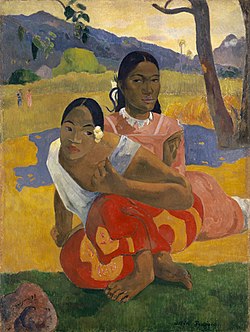
Nafea faa ipoipo? (When Will You Marry?
Gauguin's life inspired W. Somerset Maugham's novel The Moon and Sixpence. Mario Vargas Llosa based his 2003 novel The Way to Paradise on Gauguin's life, and that of his grandmother Flora Tristan.
Actor Anthony Quinn portrayed Gauguin in the 1956 Van Gogh biopic Lust for Life and won the Academy Award for Best Supporting Actor for his performance. Oscar Isaac played Gauguin in the later Van Gogh biopic At Eternity's Gate.
Gauguin is also the subject of at least two operas: Federico Elizalde's Paul Gauguin (1943); and Gauguin (a synthetic life) by Michael Smetanin and Alison Croggon. Déodat de Séverac wrote his Elegy for piano in memory of Gauguin.
The Danish-produced film Oviri (1986) is a biographical film. It follows the painter from the time he returns to Paris in 1893 after a two-year stay in Tahiti and must confront his wife, his children and his former lover. It ends when he returns to Tahiti two years later.
The Japanese styled Gauguin Museum, opposite the Botanical Gardens of Papeari in Papeari, Tahiti, contains some exhibits, documents, photographs, reproductions and original sketches and block prints of Gauguin and Tahitians. In 2003, the Paul Gauguin Cultural Center opened in Atuona in the Marquesas Islands.
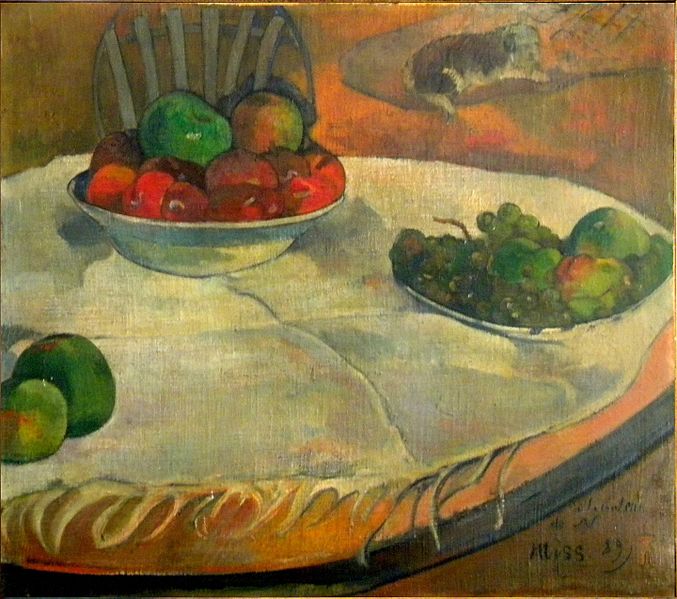
Fruits sur une table ou nature au petit chien (1889)
In 2014 the painting Fruits sur une table ou nature au petit chien (1889), with an estimated value of between €10m and €30m (£8.3m to £24.8m), which had been stolen in London in 1970, was discovered in Italy. The painting, together with a work by Pierre Bonnard, had been bought by a Fiat employee in 1975, at a railway lost property sale, for 45,000 lira (about £32).
source: wiki


